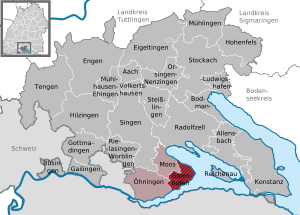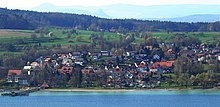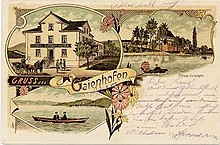Gaienhofen
| coat of arms | Germany map | |
|---|---|---|

|
Coordinates: 47 ° 41 ′ N , 8 ° 59 ′ E |
|
| Basic data | ||
| State : | Baden-Württemberg | |
| Administrative region : | Freiburg | |
| County : | Constancy | |
| Height : | 425 m above sea level NHN | |
| Area : | 12.55 km 2 | |
| Residents: | 3480 (December 31, 2018) | |
| Population density : | 277 inhabitants per km 2 | |
| Postal code : | 78343 | |
| Area code : | 07735 | |
| License plate : | KN | |
| Community key : | 08 3 35 025 | |
| LOCODE : | DE 77I | |
| Address of the municipal administration: |
Im Kohlgarten 1 78343 Gaienhofen |
|
| Website : | ||
| Mayor : | Uwe Eisch ( CDU ) | |
| Location of the municipality of Gaienhofen in the district of Konstanz | ||

Gaienhofen is a municipality on Lake Constance in the district of Konstanz in Baden-Württemberg .
geography
Geographical location
Gaienhofen is located on the south and east side of the Höri peninsula on the Untersee opposite the Swiss community of Steckborn and the (German) island of Reichenau .
Neighboring communities
The community borders on Öhningen in the southwest and Moos in the northwest . The rest of the municipal boundary is formed by the shore of the Untersee.
Community structure
Eight villages , hamlets , farms and houses belong to the municipality of Gaienhofen with the formerly independent municipalities of Gundholzen, Hemmenhofen and Horn, which have been incorporated since 1974 .
The administrative seat is in the district of Gaienhofen, as is the seat of the Höri municipal administration association , to which the municipalities of Gaienhofen, Moos and Öhningen belong.
 |
The village of Gaienhofen and the homestead Honisheim belong to the municipality of Gaienhofen within the boundaries of 1973 , as well as the lost village of Stöckenhof .
(For the old coat of arms, see also → List of coats of arms with the emblem of the Count Palatine of Tübingen ) |
 |
The former municipality of Gundholzen includes the village of Gundholzen and the houses in the Mettental - the latter border directly on the district of Iznang in the neighboring municipality of Moos - as well as the desolation of Hof in the Turbental - the field name Ob dem Hof indicates the abandoned settlement. |
 |
The village of Hemmenhofen belongs to the former municipality of Hemmenhofen . |
 |
The former municipality of Horn includes the village of Horn , the hamlet of Hornstaad , the Balesheim homestead and the desert areas of Himmern and Hofstetten . Horn is seen from the lake between the navigation marks (for shoals) two to six. The place is on a slope that descends steeply to the lake. The former Hornstaad Castle (today Seerestaurant Schlössli ) is located directly on the lake . The impassable Schiener Berg ridge extends further inland . Due to the lake location and the protected western flank of the Schiener Berg, fruit growing is possible. |
The Catholic parish church of St. Johann in Horn with its old church cemetery is a landmark of the Höri . About the unique view from the parish church in Horn on the Untersee up to the tower of the Konstanzer Minster, the saying of the Grand Duke Friedrich I of Baden is handed down: "If I weren't the Grand Duke of Baden, I wanted to be the pastor of Horn."
history
There are several Neolithic settlements in the district of Gaienhofen , for example in Hemmenhofen, Gewann “Im Leh”, and Hornstaad, Gewann “Hinterhorn”. The pile dwelling settlements Hornstaad-Hörnle I – V are Stone Age pile dwelling settlements from the period 3918–2690 BC. Investigations in the years 1973 to 1993 produced important results on economic, house building, settlement methods and social structure as well as on trade relations. Particularly noteworthy is Hornstaad-Hörnle IA on the banks of the Hörispitze, which was extensively investigated in an excavation lasting more than ten years and dendrochronological studies to around 3900 BC. Is dated. The latter has been part of the UNESCO World Heritage Site of Prehistoric Pile Dwellings around the Alps since 2011 . Finds and reconstructions can be seen in the Hermann-Hesse-Höri-Museum Gaienhofen and in the Archaeological State Museum Konstanz . The Hornstaad House can be found in the Pfahlbaumuseum Unteruhldingen as a replica for research purposes.
Gaienhofen was first mentioned in a document in 1295.
During the time of National Socialism there was a Gau school of the National Socialist Teachers' Association (NSLB) in Gaienhofen; formerly the "Seeheim of the Association of Badischer Lehrerinnen am Bodensee". In the NSLB-Gauschule Gaienhofen, the first of three permanent training centers of the Baden NSLB, so-called "teacher camps" for "ideological training" in the sense of National Socialist ideology have been held regularly since the beginning of 1934 (according to other information: 1935). One of the speakers was the local writer and Nazi propagandist Ludwig Finckh .
Today's community was re-formed on October 1, 1974 by the union of the communities Gaienhofen, Hemmenhofen and Horn. On January 1, 1974, the community of Gundholzen was incorporated into Horn.
politics
Municipal council
The last municipal council election took place on May 26, 2019 . 2,761 people were eligible to vote. The turnout increased from 66.6% in 2014 to 69.3%.
| Party / list | be right | % | Seats | 2014 result | Result 2009 |
|---|---|---|---|---|---|
| Free voters Gaienhofen (FWG) | 9,272 | 36.95 | 5 | 31.9%, 4 seats | 21.7%, 3 seats |
| Independent Citizens List (UBL) | 7,407 | 29.52 | 4th | 26.2%, 4 seats | 32.2%, 5 seats |
| The active ones | 5,274 | 21.02 | 3 | 22.5%, 3 seats | 23.0%, 3 seats |
| CDU | 4.142 | 16.51 | 2 | 19.5%, 3 seats | 23.0%, 3 seats |
| total | 25,095 | 14th |
mayor
Uwe-Michael Eisch ( CDU ) has been mayor of Gaienhofen since 1999 .
Partnerships
-
 Saint-Georges-de-Didonne in the Nouvelle-Aquitaine region of France
Saint-Georges-de-Didonne in the Nouvelle-Aquitaine region of France -
 Balatonföldvár on Lake Balaton , Hungary
Balatonföldvár on Lake Balaton , Hungary
coat of arms
The old coat of arms of Gaienhofen shows a red cross in silver, covered with a silver heart shield, inside a red [three-lobed] church flag with [three] gold rings.
The new coat of arms shows a red cross in silver, topped with a black heart shield, inside a double-row red and silver slanted bar.
Economy and Infrastructure
Educational institutions
A municipal kindergarten exists in the Horn district.
This is also where the primary school branch of the Hermann Hesse School is located. The secondary Hermann-Hesse-Werkrealschule is located in the Gaienhofen district.
Gaienhofen is also home to the Gaienhofen Castle School Center - Evangelical School on Lake Constance . The former boarding school now includes the Ambrosius-Blarer-Gymnasium with three branches: general high school , business high school and secondary school .
graveyards
- Hemmenhofen cemetery: Otto Dix's grave is located in the Hemmenhofen cemetery . A memorial plaque on the cemetery wall commemorates Erich Heckel , who was buried in the cemetery in 1970, but whose grave has already been abandoned.
- Cemetery (churchyard) around the church of Horn: The grave of Hans Leip , the author of Lili Marleen , is located in the cemetery of the Catholic parish church of St. Johann in Horn on the northwestern edge of the cemetery above the Untersee.
Culture and sights
Museums

- The Hesse Museum , which was rebuilt and redesigned in 2015, is located in a former farmhouse from the 17th century, which served as the community's school and town hall from 1868. In 1904 Hermann Hesse and his wife Mia Hesse-Bernoulli rented the living part of the house, in which the museum was initially set up. In the meantime, all rooms in the building have been integrated into the museum concept. In Hesse's former study on the upper floor you can also find the desk that Hesse had built for this apartment and that he had taken with him to his other places of residence in Bern and Montagnola . Exhibitions, lectures and other events on topics related to the life of Hermann Hesse take place in the museum rooms every year.
- The Hermann-Hesse-House in "Erlenloh" could be Mia and Hermann Hesse in 1907 by the Basel architect Hans Hindermann style reform architecture build. Attached to the house is a garden that Hesse and his wife created himself. The Hesse family lived here until 1912. The house, which still contains a lot of the original substance, was restored by a support association from 2004 onwards. The Baden-Württemberg State Monument Protection Prize was awarded for this in 2005. There are regular guided tours in the house and garden, and the house can also be visited on request.
- Museum Haus Dix : The painter Otto Dix had a house and studio built in Hemmenhofen in 1936 with the money of his wife Martha, after he had lost his professorship at the Dresden Art Academy in 1933 and retired to Lake Constance. He lived and worked there until his death. The Haus Dix Museum is a memorial to the life and work of this important German painter; it is open to the public. In 2009 the Kunstmuseum Stuttgart , which is known for its Dix collection, announced plans to take over the house, renovate it and operate it as a branch of the Kunstmuseum Stuttgart with the help of the public Otto Dix Haus Foundation, which was established in December 2009. The total cost was 1.5 million euros. On 15./16. In June 2013 it was reopened as Museum Haus Dix , branch of the Stuttgart Art Museum.
- There are several private studios and galleries in the community .
Buildings
Churches
- Catholic parish church St. Johann, Horn (12th - 18th century)
- St. Mauritius Chapel (around 1500, at the Hesse Museum)
- Evangelical Melanchthon Church (1967, Arch .: Hermann Blomeier)
Castles, museums, etc. a.
- Gaienhofen Castle
- Hermann Hesse House at the Hesse Museum
- Hermann-Hesse-Haus in "Erlenloh"
- Ludwig Finckh House
- House Dix Museum
- Water reservoir above Horn (also serves as a viewing platform)
Sculptures and works of art in public spaces
- Hermann Hesse statue by Friedhelm Zilly
- Fountain by Peter Lenk with figures from the picture Großstadt-Triptychon by Otto Dix
- Village fountain with a group of sculptures by Friedhelm Zilly in Gundholzen
Peter Lenk created a sculpture that runs across the thoroughfare.
Ferry service
The Höri ferry runs "zigzag" between the Horn district, Berlingen in Switzerland , Gaienhofen and Steckborn in Switzerland on Sundays and public holidays .
nature
- NABU bird exploration trail on the shores of Lake Constance
Personalities
Honorary citizen
- Ludwig Finckh (1876–1964), doctor, writer, in Gaienhofen since 1905. Finckh was granted honorary citizenship in 1926.
- László Berkes, former mayor of Balatonföldvár
- Hermann Biechele (1918–1999), former member of the German Bundestag
- Karl Bruttel, former mayor of the once independent municipality of Gundholzen and, after the municipal reform, a long-term councilor
- Dominique Bussereau (* 1952), Minister of Agriculture of France, former Mayor of Saint-Georges-de-Didonne
- Anneliese Oerding
Sons and daughters of the church
- Hermann Schnell (1916–1999), chemist, inventor of polycarbonate, grew up in Gaienhofen
Personalities who have worked or are working on site
- Max Ackermann (1887–1975), painter, lived in Horn, painted in Hemmenhofen
- Hermann Biechele (1918–1999), politician, lived in Gaienhofen
- Erich Bloch (1897–1994), writer, lived in Horn
- Paul Buck (1911–2006), pianist, Wagner specialist, lived in Horn and is buried there
- Max Bucherer (1883–1974), graphic artist and painter, lived and worked as a drawing teacher in Gaienhofen from 1905 to 1907
- Peter Derschka (* 1948), entrepreneur, publicist and painter, lives in Gundholzen
- Matthias Dinter (* 1968), screenwriter, director and comic artist, grew up in Gaienhofen
- Otto Dix (1891-1969), painter, lived in Hemmenhofen and is buried there
- Hugo Erfurth (1874–1948), photographer, lived in Gaienhofen
- Ludwig Finckh (1876–1964), writer and Nazi propagandist, lived in Gaienhofen
- Heinrich Hauber (1904–1983), painter, lived in Horn and is buried there
- Erich Heckel (1883–1970), painter, lived in Hemmenhofen
- Gertraud Herzger von Harlessem (1908–1989), painter, lived and worked in Gaienhofen
- Walter Herzger (1901 or 1903–1985), painter, lived and worked in Gaienhofen
- Hermann Hesse (1877–1962), writer, lived in Gaienhofen
- Walter Kaesbach (1879–1961), art historian, lived in Hemmenhofen
- Bodo Kirchhoff (* 1948), writer, went to school in Gaienhofen
- Karl Kling (1910–2003), racing driver, lived in Hemmenhofen
- Helmuth Macke (1891–1936), painter, lived in Hemmenhofen
- Josef Michel (1928–2002), church musician and composer, lived and worked in Gaienhofen
- Johannes Matthias Michel (* 1962), church musician and composer, grew up in Gaienhofen
- Klaus Nonnenmann (1922–1993), writer, lived in Gaienhofen
- Bertha von Petersenn (1862–1910), founder and director of the Landerziehungsheim für Mädchen Schloss Gaienhofen
- Georg von Petersenn (1849–1930), professor at the Berlin Musikhochschule, taught music in the state educational home for girls at Gaienhofen Castle
- Jacob Picard (1883–1967), writer, stayed in an inn in Horn from 1936–1938
- Friedrich Rau (1916–2001), lawyer, former member of the Bundestag, lived in Hemmenhofen
- René Sydow (* 1980), writer, cabaret artist, actor and director, went to school in Gaienhofen
- Christoph Theinert (* 1959), musician, worked in Gaienhofen
- Rudolf Thome (* 1939), director, went to school in Gaienhofen
- Emil Wachter (1921–2012), painter, worked in Gaienhofen
- Douglas Wolfsperger (* 1957), director, went to school in Gaienhofen
Web links
Individual evidence
- ↑ State Statistical Office Baden-Württemberg - Population by nationality and gender on December 31, 2018 (CSV file) ( help on this ).
- ^ The state of Baden-Württemberg. Official description by district and municipality. Volume VI: Freiburg administrative region. Kohlhammer, Stuttgart 1982, ISBN 3-17-007174-2 , pp. 738-740.
- ^ Wilhelm Büsing: Description of the shore of Lake Constance with an overview map. Publisher Paula Büsing, Konstanz 1984, p. 80.
- ↑ Memorial plaque on the outer wall of the parish church of Horn by the Horn-Gundholzen tourist office
- ↑ Source: Vorarlberger Landesmuseum Bregenz, in: Listed! Finds of pile dwellings on the Untersee. In: Südkurier . September 9, 2011.
- ↑ UNESCO World Heritage Center: Six new sites inscribed on UNESCO's World Heritage List. June 27, 2011
- ↑ UNESCO World Heritage Center: Prehistoric Pile dwellings around the Alps , number 1363-074, Hornstaad-Hörnle
- ↑ See this: Ingeborg Wiemann-Stöhr: Die pedagogical mobilization. School in Baden under the sign of National Socialism. Verlag Julius Klinkhardt, Bad Heilbrunn 2018, ISBN 978-3-7815-2217-6 , p. 76 ff.
- ^ Federal Statistical Office (ed.): Historical municipality directory for the Federal Republic of Germany. Name, border and key number changes in municipalities, counties and administrative districts from May 27, 1970 to December 31, 1982 . W. Kohlhammer, Stuttgart / Mainz 1983, ISBN 3-17-003263-1 , p. 519 .
- ↑ Municipal council elections 2019 - Gaienhofen (Konstanz district). In: statistik-bw.de. Statistical State Office of Baden-Württemberg, accessed on July 29, 2019 .
- ↑ Höri week . Volume 19, No. 22 , 31 May 2019, p. 9 ( gaienhofen.de ( Memento from July 29, 2019 in the Internet Archive ) [PDF]).
- ↑ Gaienhofen Castle. Evangelical school on Lake Constance
- ↑ Otto Dix's grave in the Hemmenhofen cemetery.
- ↑ The abandoned grave of Erich Heckel in the Hemmenhofen cemetery
- ↑ Torsten Lucht: Rebellion against the last rest. In: Südkurier. March 26, 2016, p. 21.
- ^ Grave of Hans Leip in Horn, district of Gaienhofen on www.gaienhofen.de
- ↑ Article: Insider tips for parks & gardens: Gaienhofen - Hesse's Refugium , In: Monumente , issue 4/2020, p. 14.
- ↑ Monuments Online 5.2012
- ↑ Birgit Kölgen: The professionals should take over. In: Schwäbische Zeitung . April 28, 2010.
- ↑ Birgit Kölgen: Otto Dix House. The man who loved women. In: Schwäbische Zeitung. April 28, 2010.
- ^ Report of the Stuttgarter Zeitung on the reopening of the Otto-Dix-Haus
- ^ Museum Haus Dix, Hemmenhofen
- ^ Gaienhofen.de: studios and galleries









